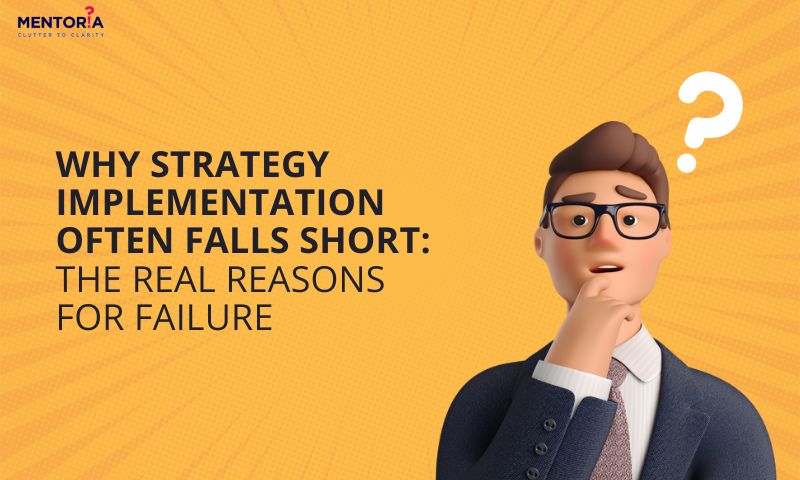Why Strategy Implementation Often Falls Short: The Real Reasons for Failure

Strategy implementation is the process of turning a strategic plan into action. It involves allocating resources, setting goals, assigning tasks, and monitoring progress. However, many organisations struggle to execute their strategies effectively, resulting in wasted time, money, and opportunities. What are the common reasons for strategy implementation failure, and how can they be avoided?
In this blog, I will explore some of the factors that contribute to strategy implementation failure, and provide some suggestions for improving the chances of success. I will focus on four main aspects: leadership, communication, alignment, and adaptation. I will argue that these are essential elements for creating a culture of strategy execution, and that without them, any strategy is doomed to fail.
Lack Of Alignment
Lack of alignment in strategy implementation refers to a disconnect between the overarching strategic objectives of an organisation and the actions taken at different levels within the company. When employees aren’t fully tuned into strategic goals or how their roles fit into the big picture, it can create a disconnect between strategy and day-to-day work. Different teams might prioritise their own objectives over the organisation’s overall strategy, leading to conflicts in resource use. If leadership fails to effectively communicate the strategy, employees may miss out on the broader goals, causing a lack of alignment in their actions. Some employees, disengaged or resistant to change, might not actively contribute to aligning their efforts with the strategy, creating a gap between plans and execution.
To bridge this gap, clear and regular communication about the strategy’s importance and how everyone contributes is key. Aligning individual and team goals with the broader strategy helps everyone see their impact. Setting up channels for feedback and open communication allows employees to share concerns and ideas about strategy and its implementation. Leaders walking the talk, showing commitment, and engaging with employees actively can foster alignment. Providing training and development opportunities helps employees understand the strategy better and gain the skills they need to contribute effectively.
Tackling these areas can help organisations align their workforce toward common goals, ensuring strategy and execution walk hand in hand. Procter & Gamble (P&G) is carving its path to success by embracing “constructive disruption” and a nimble, accountable organisational structure, a strategy outlined in their company message. This commitment to sustainable growth and value creation entails expanding their innovations portfolio and optimising existing products. Central to their journey is a dedicated focus on customer needs and the agility to adapt to their ever-evolving preferences.
P&G’s success story is a blend of technology and human insights. They intricately analyse customer behaviour using advertising algorithms, automated tests for digital shelf placement, and sustainable marketing strategies. For context, the company invests a whopping $400 million in consumer research and allocates nearly $2 billion yearly to Research and Development, ensuring continuous growth in their innovations. These strides signify a robust commitment to staying ahead in a competitive market.
Their achievements stem from an agile company culture founded on effective leadership, empowering individuals, and a steadfast dedication to positive impacts and sustainability. This ethos has propelled P&G to become the world’s largest consumer goods company, boasting a global net sales figure of $82 billion for the fiscal year 2023.
Insufficient Resources
Insufficient resources can severely hamper the successful implementation of a strategy. Limited budgets can restrain investments essential for technology, infrastructure, hiring, and other crucial elements vital for executing a strategy. A shortage of skilled personnel or expertise in specific areas can impede implementing certain parts of the strategy. Outdated or inadequate technology can hinder progress, especially in today’s tech-driven landscape where strategies rely heavily on advanced tools. Not allocating enough time for strategy implementation can lead to rushed decisions and ineffective planning.
Identifying critical areas where resources are most needed is key. Assessing where resources can have the most impact is crucial. Finding ways to optimise existing resources, streamline processes, and cut inefficiencies maximises what’s available.
Focusing investments in areas vital for executing the strategy is crucial. It might involve reallocating budgets or seeking extra funding. Boosting existing personnel’s skills through training or hiring individuals with necessary expertise can bridge skill gaps. Investing in technological upgrades aligned with the strategy’s needs is essential. Efficient time management through realistic timelines and clear deadlines prevents unnecessary delays. A comprehensive evaluation of resource needs, strategic prioritisation, and adaptability to invest in vital areas can help overcome the challenges of insufficient resources during strategy implementation.
Resource Forecasting: Picture this: a project manager gearing up for a six-month website development and design project. Imagine a dynamic team involving developers, testers, UI/UX designers, analysts—the whole crew! Now, this manager needs a foolproof plan to forecast and manage resources smartly for a seamless project journey.
First off, it’s all about nailing down the project’s nitty-gritty—its goals, scope, deliverables, and that oh-so-important timeline. Then, the manager and team dive into the specifics, listing out every task needed to make that website a reality. Once that’s done, it’s time for the magic: resource assessment. With nifty forecasting tools, they calculate the manpower required for each project phase, foresee peak resource demands, and sniff out any potential shortage or overflow. This resource forecasting dance isn’t just about numbers; it’s about ensuring the right people land in the right spots at the perfect moment.
Resistance to Change
Resistance to change is a common human response that can hinder strategy implementation. It can stem from fear of the unknown, comfort with the status quo, perceived loss, and lack of involvement. When it comes to managing resistance within organisations, creating a dynamic engagement strategy is key. It’s all about fostering crystal-clear communication that not only outlines the reasons behind the change but also highlights its benefits and how it syncs with the overarching goals. Engaging employees by actively seeking their thoughts and weaving their ideas into the change process can truly bolster their sense of belonging and dedication. Add a touch of empathy and attentive listening to address concerns, couple that with tailor-made training programmes to help everyone adapt seamlessly, and top it off with unwavering leadership support. If possible, introducing changes gradually can make the adjustment period smoother, allowing individuals to acclimate at their own pace. By diving into the core reasons causing resistance and getting everyone involved in the change journey, organisations can craft a more upbeat and welcoming atmosphere, which is absolutely critical for a successful strategy implementation.
Sophos migrated to Salesforce CRM: Sophos, a major player in cybersecurity, grappled with the whirlwind of changes accompanying frequent Salesforce updates. With Salesforce being their go-to tool for sales streamlining, the sales operations crew found themselves drowning amidst the influx of new features, interface tweaks, and workflow adjustments.
But guess what they did to tackle this challenge? They brought in Whatfix, a digital adoption platform (DAP), to rescue the team. This nifty tool offered interactive, on-the-spot training that helped the crew sail through updates and ace all those intricate Salesforce features.
So, what was in Sophos’ playbook?
- They cooked up interactive guides that walked everyone through the Salesforce basics.
- They got these cool step-by-step guides going, making learning a part of the work journey.
- Smart tooltips—yep, they popped up right within Salesforce, explaining every new button in the interface.
- They amped up communication with embedded videos and other media, making sure the sales and product management teams were singing the same tune.
Poor Communication
Poor communication during strategy implementation can lead to misunderstandings and confusion within an organisation. This can be attributed to lack of clarity, inconsistent messaging, insufficient feedback, and timing and relevance. To improve communication, organisations should ensure clear and consistent messaging across all levels, encourage open dialogue, customise messages to suit different teams or departments, use multiple channels to reach a diverse audience, offer training and education to help employees understand the strategy’s nuances, and ensure leadership visibility.
To enhance communication, organisations should focus on clear, consistent, and two-way communication, encourage open dialogue, provide feedback loops, and customise messages to suit different teams or departments. Additionally, organisations should utilise multiple channels to reach a diverse audience and offer training sessions or resources to help employees understand the strategy’s nuances and their role in its implementation. By fostering clear, consistent, and two-way communication, organisations can mitigate misunderstandings, align efforts, and ensure everyone is on the same page during strategy implementation.
Ineffective Leadership
Ineffective leadership can significantly hinder strategy implementation within an organisation. When leaders fall short in painting a vivid and compelling vision, it can leave employees in the dark, leading to confusion and a lack of focus in their efforts. Poor communication around strategy, its objectives, and the reasoning behind decisions can breed uncertainty and reluctance among teams. Leaders who micromanage or struggle with effective delegation risk stifling creativity and hindering the strategy’s execution. When leaders themselves are hesitant about change, it sends a signal that discourages teams from embracing new approaches. Consistent support and resource allocation are key; wavering priorities or inadequate resources can derail the implementation process.
To enhance leadership effectiveness during strategy implementation: Leaders need to craft a crystal-clear, motivating vision and ensure everyone’s on board. Open, transparent communication about the strategy’s progress and reasons behind changes is crucial for engaging employees. Foster a culture of empowerment by delegating responsibilities, trusting your team, and offering support. Leaders should embody adaptability and change, serving as an example for others. Consistently back the strategy with resources and align daily activities with strategic goals. Encourage feedback loops and be flexible to adjust strategies based on insights and evolving situations. Effective leadership is the linchpin for successful strategy execution. When leaders display clarity, strong communication, adaptability, and a commitment to empowering their teams, it significantly boosts the odds of executing strategies successfully.
Lack of Flexibility and Adaptability
A rigid approach to strategy implementation can hinder an organisation’s ability to respond to changing circumstances or unforeseen challenges. This inflexibility can show up in various forms, like sticking rigidly to initial plans, resisting change, not learning from feedback, or being overly committed to a single approach. To promote flexibility and adaptability in executing strategies, companies should adopt an agile mindset, embrace innovation, welcome change, and prioritise continuous learning. With global headquarters in Toyota, Aichi Prefecture, Japan, Toyota maintains North American headquarters in Plano, Texas, as well as a network of offices, factories, and authorised dealerships across 170 countries. Employing more than 350,000 professionals throughout the world, the company supports diverse perspectives and unique human experiences. In the past, Toyota has posted positions for a plethora of flexible jobs, including analyst jobs and full-time, part-time, and remote jobs in engineering, sales, customer service, and consulting.
An agile approach allows for ongoing adjustments based on feedback and evolving circumstances, encouraging teams to adapt plans iteratively. Embracing innovation motivates teams to explore fresh solutions or methods. Embracing change highlights that growth sometimes demands embracing new directions. Continuous learning fosters a culture that sees failures as stepping stones for improvement. Flexibility in decision-making empowers teams to act swiftly without getting tied up in rigid hierarchies. Scenario planning helps anticipate possible changes and create backup plans for unexpected shifts. By nurturing a culture that values flexibility, embraces change, and encourages adaptability, organisations can handle uncertainties more effectively during strategy implementation and stay agile in a dynamic environment.
Clear communication is key, ensuring everyone comprehends the strategy’s goals and their role in achieving them. Leadership sets the tone, offering support and cultivating a culture that values adaptability, innovation, and openness to change. Overcoming resistance by involving employees, providing resources, and continual support heightens the odds of successful implementation. A flexible approach that allows adjustments, learns from experiences, and embraces adaptation is vital in a continually changing business landscape. Addressing these challenges holistically and fostering a collaborative, adaptable environment helps organisations navigate the complexities of strategy implementation effectively, boosting their chances of long-term success.
Increasing Career Success With Mentoria
By recognising and addressing these common pitfalls, organisations can increase their chances of successfully implementing their strategies and achieving their long-term goals. Mentoria’s mentorship programme pairs children with mentors who are successful professionals in their fields. Mentors provide children with guidance, advice, and support, helping them to develop their confidence, set goals, and overcome challenges. Mentoria also offers a variety of career guidance programmes, including workshops, seminars, and internships. These programmes help children to learn about different career paths, develop their skills, and network with professionals.








